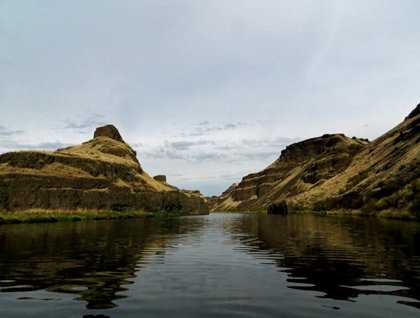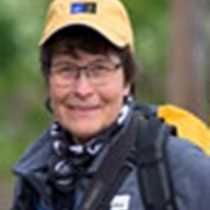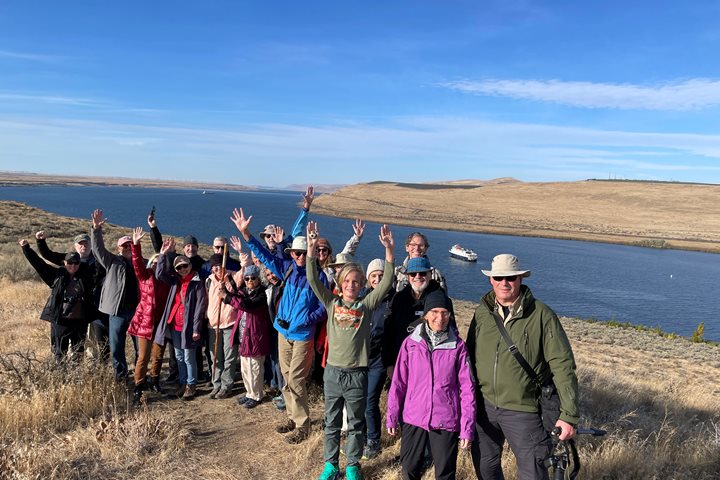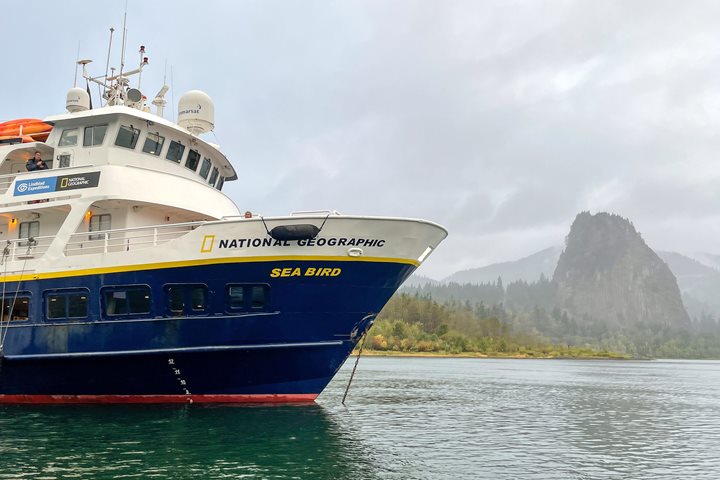At 0630 hours in the still darkness the National Geographic Sea Bird is approaching Little Goose Dam on the Snake River. The dam lights shine in a bright line across the dark water. Soon Captain Kay eases the ship into the lock and our sailors expertly toss a line over the floating bollard and our ship is made fast for our lockage. Water drains from the lock and we are lowered 97.5 feet to the level of the river below. We sail forth now into the soft light of dawn. Layered flows of brown basalt step up away from the river on either side. The dark rock contrasts with the buff-colored grasses of autumn that cover all but the vertical rock faces.
Soon we are turning into the mouth of the Palouse River, dropping anchor, and preparing for our adventures of the day. Our expedition landing craft are launched and we are on our way to kayaking, an overland trip in a yellow school bus to Palouse Falls, and cruising up the Palouse River looking for wildlife.
Kayakers board their bright yellow crafts and ply their paddles to glide toward and examine the nearest columnar basalt. The basalt rock forms a steep and sculptured cliff that falls straight down into the water. The columns are beautifully weathered to earthy browns and reds. Travelers to the waterfall are amazed to see the Palouse River running over the lip of a precipice and cascading into its green plunge pool nearly 200 feet below. The falls are surrounded by vertical cliffs of basalt that were ravaged and plucked apart by humongous Ice Age floods thousands of years ago. Those of us on the river cruise see signs of Ice Age flood deposits in giant gravel bars along the river. We see beaver lodges and the small trees the beavers have cut down and stored in the water to be used as winter food. Western grebes with their long, graceful necks, red eyes, and sharp beaks swim by. An American coot flies past and mallard ducks burst from the water in flight, quacking as they go. Two great golden eagles are spotted, one perched on a high cliff, and one on the wing. Then they are both soaring above. Coming from the high slope above us and near the eagles we hear a sharp repeated whistle—perhaps the alarm cry of a yellow-bellied marmot disturbed by the nearness of the eagles.
Back on the Snake River in the afternoon we marvel at the beautiful cliffs and the fantastic patterns in the basalt on the hills and cliffs. Then we come to Lower Monumental Dam and lock. The most adventurous among us board the expedition landing craft and go in them through the lock. Don, our historian gives a fascinating presentation on Lewis and Clark. During Recap we come to the confluence of the Snake and Columbia Rivers. We sail onto the Columbia and proceed westward on upon the waters of the Great River of the West. This wonderful day is capped with an illuminating presentation about the edible plants of Lewis and Clark by Linda, our photography instructor/naturalist.







